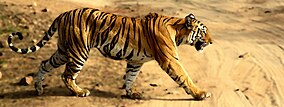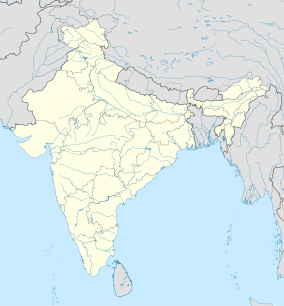Bandhavgarh National Park
| Bandhavgarh National Park | |
|---|---|
 A tigress that is a descendant of tigress Sita and male Charger in Bandhavgarh | |
| Location | Madhya Pradesh, India |
| Nearest city | Umaria |
| Coordinates | 23°41′58″N 80°57′43″E / 23.69944°N 80.96194°E |
| Area | 1,536 km2 (593 sq mi) |
| Established | 1968 Tiger Reserve in 1993 |
| Visitors | 176,051 (in 2022)[1] |
| Governing body | Madhya Pradesh Forest Department |
| forest.mponline.gov.in/ | |
Bandhavgarh National Park is a national park of India, located in the Umaria district of Madhya Pradesh. Bandhavgarh, with an area of 105 square kilometres (41 sq mi), was declared a national park in 1968 and then became Tiger Reserve in 1993. The current core area is spread over 716 square kilometres (276 sq mi).
This park has a large biodiversity. The park has a large breeding population of leopards, and various species of deer. Maharaja Martand Singh of Rewa captured the first white tiger in this region in 1951. This white tiger, Mohan, is now stuffed and on display in the palace of the Maharajas of Rewa. Historically villagers and their cattle have been at a threat from the tiger. Rising mining activities around the park are putting the tigers at risk. The park derives its name from the most prominent hill of the area, which is said to have been given by Lord Rama to his brother Lakshmana to keep a watch on Lanka (Bandhav = Brother, Garh = Fort). The fort was built by a Gond Dynasty king.
Structure
[edit]The three main zones of the national park are Tala, Magdhi and Khitauli. Tala is the richest zone in terms of biodiversity, mainly tigers. Altogether, these three ranges comprise the 'core' of the Bandhavgarh Tiger Reserve, constituting a total area of 716 km2.
Fauna
[edit]

With the tiger at the apex of the food chain, it contains at least 37 species of mammals. According to forest officials, there are more than 250 species of birds, about 80 species of butterflies, a number of reptiles. But many people have the species' list of about 350 birds along with photographs. The richness and tranquity of grasslands invites pairs of sarus cranes to breed in the rainy season.
One of the biggest attractions of this national park is the Bengal tiger (Panthera tigris tigris). Bandhavgarh has a very high density of tigers within its jungles. The 105 km2 of park area open to tourists was reported to have 22 tigers, a density of one tiger for every 4.77 km2. (Population estimation exercise 2001). The population of tigers in the park in 2012 was about 44–49. There is a saying about the Park that goes: "In any other Park, you are lucky if you see a tiger. In Bandhavgarh, you are unlucky if you don't see (at least) one." Bandhavgarh has one of the highest density of tigers known in the world and is home to some well-known tigers which are large. Charger, a tiger so named because of his habit of charging at elephants and tourists (whom he nonetheless did not harm), was the first healthy male known to be living in Bandhavgarh since the 1990s, as well as a female known as Sita. Charger once appeared on the cover of National Geographic and is considered the second most photographed tiger in the world. Almost all the tigers of Bandhavgarh today are descendants of Sita and Charger. Their daughter Joita, sons Langru and B2 also maintained their tradition for frequent sighting and moving close to tourist vehicles. Mohini, another female, became prominent following Sita's death. She mated with the male tiger, Mahaman. She later died of her wounds from a vehicle accident. Charger died in 2000 and his body was buried at Charger Point where he was kept in a closed region at his old age. Between 2003 and 2006, many of his descendants met with a series of unfortunate ends. B1 was electrocuted and B3 was killed by poachers. Sita was killed by poachers too. After the death of Charger, the fully grown B2 survived as the dominant male in the forest between 2004 and 2007. Mating with a female in the Siddhababa region of Bandhavgarh, he became father of three cubs. One of them was a male. He was named Bamera. He was first sighted in 2008 and is now Bandhavgarh's dominant male. In November 2011, B2 died. Postmortem studies suggest that he died a natural death. But some [who?] claim that he was injured by the locals from the village in the buffer area. Now, the most prominent tiger in Tala zone of Bandhavgarh National Park is Bamera (died recently). However, of late[when?] he has been challenged on several occasions by a new male. Blue Eyes (died recently due to drug over dose) and Mukunda are the dominant males of Magdhi and Khitauli zone respectively. The females who are seen more frequently are Rajbehra, Mirchaini, Banbehi, Mahaman, Sukhi Pattiya and Damdama. There are quite a few cubs also who are either in sub-adult stage or have entered adulthood and are separate now.[citation needed]

The reserve is also densely populated with other species: the gaur or Indian bison (Bos gaurus gaurus), are now extinct or have migrated elsewhere; sambar and barking deer are a common sight, and nilgai are to be seen in the open areas of the park. There have been reports of the Indian wolf (Canis lupus pallipes), striped hyena (Hyaena hyaena hyaena) and the caracal (Caracal caracal schmitzi) the latter being an exclusive open area dweller. The tiger reserve abounds with chital or the spotted deer (Axis axis) which is the main prey animal of the tiger and the Indian leopard (Panthera pardus fusca). The Indian bison were reintroduced from Kanha.
Reintroduction of gaur
[edit]Bandhavgarh National Park had a small population of gaur, but due to disease passed from cattle to them, all of them died. The project of reintroduction of gaurs dealt with shifting some gaurs from Kanha National Park to Bandhavgarh. 50 animals were shifted by the winter of 2012. This project was executed by Madhya Pradesh Forest department, Wildlife Institute of India and Taj Safaris by technical collaboration.[2]
Elephants
[edit]In the summer of 2018, a herd of 40-45 migrant elephants made their way into the sprawling landscape of Bandhavgarh from the neighboring state of Chattisgarh and Orissa border. Madhya Pradesh did not have a resident elephant population for over a century till 2018. The last of record was from 1905, in the Amarkantak region of the Anuppur district. Most wildlife biologists believed that they would eventually leave, as the landscape was fairly dry with limited waterbodies. But these migrant elephants in India surprised everyone, as they continued to thrive in the vast bamboo forests of Khitauli and beyond for the last five years. The Bandhavgarh National Park currently has a population of roughly 60 elephants.[3]In October 2024, a total of 10 elephants died consuming mycotoxins associated with the Kodo millet.[4]
Transportation
[edit]Bandavgarh National Park is roughly 4.5hrs (~200kms) drive from the nearest major city, Jabalpur. Jabalpur is very well connected to Delhi, Mumbai, Bangalore, Hyderabad, Pune and Indore via air travel. Bandhavgarh does not have the airport facility for mainstream flights, but Jabalpur city, which is the nearest city to Bandhavgarh, has good air connectivity with major cities of India. Private charters can land near Bandhavgarh National Park, Umaria district also has a small air-strip facility for charter planes. Jabalpur Airport (199 km/04:30hrs) is the best option to reach Bandhavgarh National Park as it is connected to: Delhi, Mumbai, Bangalore, Kolkata, Hyderabad, and Bhopal, with these airline options AirIndia, SpiceJet & IndiGo.
Train
[edit]Travel by train is another good option. Travel to Umaria station by train and hire a cab or taxi to the National Park.
Birds
[edit]Some of the typical and peculiar birds found in Bandhavgarh national park are
- Plum-headed parakeet
- Green-headed barbet
- Orange-headed thrush
- Brown-headed barbet
- Coppersmith barbet
- Common myna
- Alexandrine parakeet
- Indian grey hornbill
- Rock pigeon
- House crow
- Carrion crow
- Little egret
- Cattle egret
- Great egret
- Black drongo
- Pond heron
- Common snipe
- Black-winged stilt
- Red-wattled lapwing
- Indian peafowl
- Greater coucal
- Oriental magpie robin
- Indian roller
- Indian robin
- Eurasian collared dove
- Hoopoe
- Sirkeer malkoha
- Large-billed crow
- White-browed fantail flycatcher
- Yellow-crowned woodpecker
- Rufous treepie (normal and pallida)
- Lesser adjutant stork
- Oriental white eye
- Olive-backed pipit
- Spotted dove
- White-throated kingfisher
- Red-rumped swallow
- Lesser whistling teal
- Common kingfisher
- Black stork
- Asian green bee-eater
- Greater racket-tailed drongo
- Red-vented bulbul
- Long-billed vulture
- Grey-capped pygmy woodpecker
- Chestnut-shouldered petronia
- Crested serpent eagle
- Black redstart
- Brahminy starling
- Brown fish owl
- Yellow-footed green pigeon
- Malabar pied hornbill
- Common kestrel
- White-throated fantail flycatcher
- Rufous woodpecker
- Sapphire flycatcher
- Crested hawk eagle (Cirrhatus)
- Oriental turtle dove
- White-rumped vulture
- Lesser kestrel
- Large cuckooshrike
- Pied bushchat
- Black-winged cuckooshrike
- Black-rumped flameback woodpecker
- House sparrow
- Golden oriole
- Rose-ringed parakeet
- Paddyfield pipit
- Dusky crag martin
- Long-tailed shrike
- Black ibis
- White-necked stork
- Purple sunbird
- Giant leafbird
- Tickell's flowerpecker
- Little cormorant
- Little brown dove
- White-tailed swallow
- Jungle babbler
- Shikra
- Jungle myna
- Common tailorbird
- Red collared dove
- Red-necked vulture
- Painted francolin
- Eurasian thick-knee
- Common sandpiper
- Lesser spotted eagle
- Greater whistling teal
- Great cormorant
- Pied kingfisher
- Laughing dove
- Bonelli's eagle
- Dark black crow
- Asian pied starling
- Asian Duck
See also
[edit]References
[edit]- ^ "15L tourists visited MP's 11 national parks till July". The Times of India. 16 September 2022. Archived from the original on 30 September 2022. Retrieved 7 April 2023.
- ^ "Reintroduction of Gaur (Indian Bison) in Bandhavgarh National Park". Archived from the original on 2013-03-03. Retrieved 2012-04-16.
- ^ "Elephants in India". Bandhavgarh National Park. 28 September 2023. Retrieved 2024-10-15.
- ^ Service, Express News (2024-10-31). "Death toll of wild elephants rises to 10 at MP's Bandhavgarh Tiger Reserve". The New Indian Express. Retrieved 2024-10-31.
- Aqeel Farooqi: A Tribute to Charger [1]
- L.K.Chaudhari & Safi Akhtar Khan: Bandhavgarh-Fort of the Tiger, Wild Atlas Books, Bhopal, 2003
- Shahbaz Ahmad: Charger: The Long Living Tiger, Print World, Allahabad, 2001 ISBN 8177380003
- W.A.Rodgers, H.S.Panwar and V.B.Mathur: Wildlife Protected Area Network in India: A review, Wildlife Institute of India, Dehradun, 2000
- Captain J.Forsyth: The Highlands of Central India, Natraj Publishers, Dehradun, 1994. [2]
External links
[edit]![]() Bandhavgarh travel guide from Wikivoyage
Bandhavgarh travel guide from Wikivoyage
- In tiger territory, A.J.T.Johnsingh and Dhananjai Mohan
- Bandhavgarh- Project Tiger
- Forest resource use by people in Protected Areas and its implications for biodiversity conservation: The case of Bandhavgarh National Park in India[permanent dead link]
- Wildlife Times: The Central Indian Tiger Pilgrimage - A trip report
- Map and details of Bandhavgarh Tiger Reserve in Project Tiger website


